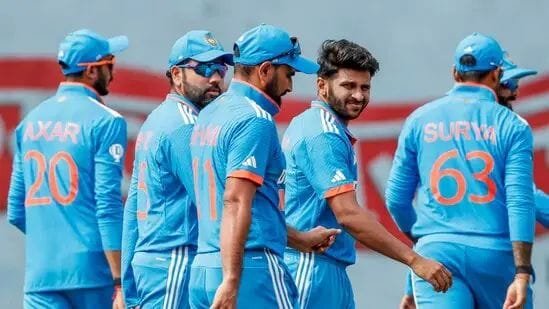India named their 15-man squad last week for the upcoming ODI World Cup as they hope to become the fourth host nation in a row to claim victory in the ICC’s premier white-ball competition.
The pressure on the team will be immense as India look to emerge from a long barren run in ICC events, having not triumphed in any tournament since the 2013 Champions Trophy.
While the squad that the BCCI has announced is packed with experience and quality, some question marks remain around a few key areas. Some analysis is, therefore, needed to determine whether or not India have picked the right balance to finally get the monkey off their backs and win some silverware.
The batting
Captain Rohit Sharma will obviously take up his habitual place at the top of the order. The skipper scored five centuries in nine innings in the last World Cup, back in 2019, so he has clear pedigree at this level and will come into the tournament in good form having scored three half-centuries in the ongoing Asia Cup.
Rohit’s opening partner, Shubman Gill, is at the opposite end of his career and has endured a mixed run of form that saw him post just one innings of substance during the recent tour to West Indies. Since then, he has recovered with two half-centuries against Nepal and Pakistan and a century against Bangladesh in the Asia Cup. He will undoubtedly be more comfortable in home conditions.
Virat Kohli, Shreyas Iyer, KL Rahul and Hardik Pandya will most likely make up the rest of the top six for the hosts. It is a batting unit packed with quality in the ODI format, but one major concern will be the lack of a left-hander. Of the other major contenders to win the World Cup, all of England, Australia, New Zealand, South Africa and Pakistan have spin bowlers who take the ball away from the right-hander, which could leave India very vulnerable especially in the middle overs and even more so if the pitch is conducive to spin.
The lack of a left-hander gives the batting unit a somewhat samey feel. One possible solution would be to bring in Ishan Kishan for either Iyer or Rahul, to break up the bank of right-handers, add some variety and give opposition teams another dimension to think about. Kishan impressed in the Caribbean with three successive half-centuries and has the fastest ODI double century to his name. This might be his first World Cup, but he has shown enough to suggest that he is ready to step up and provide that much-needed point of difference for this Indian batting line-up.
The bowling
India have included Ravindra Jadeja and Axar Patel in their squad, despite both players possessing a similar skillset as left-arm spinners who can balance the team by batting at No.7 in the order. The likelihood is that Jadeja will start ahead of Axar, with the latter only playing if conditions require three spinners.
The two left-arm spinners alongside Kuldeep Yadav would constitute a strong spin unit, but again India run the risk of lacking variety, with the lack of a frontline off-spinner a glaring omission in their squad. Ravichandran Ashwin has only played two ODIs in the last six years and is generally no longer considered in this format, but his ability to bowl to left-handers could have proved invaluable, not to mention his batting skills that would have shortened a lengthy tail.
While Kuldeep’s stock ball does turn away from the left-hander, the wrist-spinner’s record against left-handers is solid but unspectacular, with an economy rate of 5.10 (compared to 5.11 against right-handers) and an average of 23.12 (compared to 27.40 against right-handers). Ashwin meanwhile goes at a miserly 4.64 against left-handers while his average is admittedly a fraction higher than Kuldeep’s at 25.25.
With Australia, New Zealand, England and South Africa all likely to field at least three left-handers in their top seven, it is very much an area of concern that the top teams will look to exploit against this India bowling attack.







